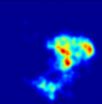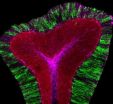(Press-News.org) When a woman experiences a stressful event early in pregnancy, the risk of her child developing autism spectrum disorders or schizophrenia increases. Yet how maternal stress is transmitted to the brain of the developing fetus, leading to these problems in neurodevelopment, is poorly understood.
New findings by University of Pennsylvania School of Veterinary Medicine scientists suggest that an enzyme found in the placenta is likely playing an important role. This enzyme, O-linked-N-acetylglucosamine transferase, or OGT, translates maternal stress into a reprogramming signal for the brain before birth.
"By manipulating this one gene, we were able to recapitulate many aspects of early prenatal stress," said Tracy L. Bale, senior author on the paper and a professor in the Department of Animal Biology at Penn Vet. "OGT seems to be serving a role as the 'canary in the coal mine,' offering a readout of mom's stress to change the baby's developing brain."
Bale also holds an appointment in the Department of Psychiatry in Penn's Perelman School of Medicine. Her co-author is postdoctoral researcher Christopher L. Howerton. The paper was published online in PNAS this week.
OGT is known to play a role in gene expression through chromatin remodeling, a process that makes some genes more or less available to be converted into proteins. In a study published last year in PNAS, Bale's lab found that placentas from male mice pups had lower levels of OGT than those from female pups, and placentas from mothers that had been exposed to stress early in gestation had lower overall levels of OGT than placentas from the mothers' unstressed counterparts.
"People think that the placenta only serves to promote blood flow between a mom and her baby, but that's really not all it's doing," Bale said. "It's a very dynamic endocrine tissue and it's sex-specific, and we've shown that tampering with it can dramatically affect a baby's developing brain."
To elucidate how reduced levels of OGT might be transmitting signals through the placenta to a fetus, Bale and Howerton bred mice that partially or fully lacked OGT in the placenta. They then compared these transgenic mice to animals that had been subjected to mild stressors during early gestation, such as predator odor, unfamiliar objects or unusual noises, during the first week of their pregnancies.
The researchers performed a genome-wide search for genes that were affected by the altered levels of OGT and were also affected by exposure to early prenatal stress using a specific activational histone mark and found a broad swath of common gene expression patterns.
They chose to focus on one particular differentially regulated gene called Hsd17b3, which encodes an enzyme that converts androstenedione, a steroid hormone, to testosterone. The researchers found this gene to be particularly interesting in part because neurodevelopmental disorders such as autism and schizophrenia have strong gender biases, where they either predominantly affect males or present earlier in males.
Placentas associated with male mice pups born to stressed mothers had reduced levels of the enzyme Hsd17b3, and, as a result, had higher levels of androstenedione and lower levels of testosterone than normal mice.
"This could mean that, with early prenatal stress, males have less masculinization," Bale said. "This is important because autism tends to be thought of as the brain in a hypermasculinized state, and schizophrenia is thought of as a hypomasculinized state. It makes sense that there is something about this process of testosterone synthesis that is being disrupted."
Furthermore, the mice born to mothers with disrupted OGT looked like the offspring of stressed mothers in other ways. Although they were born at a normal weight, their growth slowed at weaning. Their body weight as adults was 10-20 percent lower than control mice.
Because of the key role that that the hypothalamus plays in controlling growth and many other critical survival functions, the Penn Vet researchers then screened the mouse genome for genes with differential expression in the hypothalamus, comparing normal mice, mice with reduced OGT and mice born to stressed mothers.
They identified several gene sets related to the structure and function of mitochrondria, the powerhouses of cells that are responsible for producing energy. And indeed, when compared by an enzymatic assay that examines mitochondria biogenesis, both the mice born to stressed mothers and mice born to mothers with reduced OGT had dramatically reduced mitochondrial function in their hypothalamus compared to normal mice. These studies were done in collaboration with Narayan Avadhani's lab at Penn Vet.
Such reduced function could explain why the growth patterns of mice appeared similar until weaning, at which point energy demands go up.
"If you have a really bad furnace you might be okay if temperatures are mild," Bale said. "But, if it's very cold, it can't meet demand. It could be the same for these mice. If you're in a litter close to your siblings and mom, you don't need to produce a lot of heat, but once you wean you have an extra demand for producing heat. They're just not keeping up."
Bale points out that mitochondrial dysfunction in the brain has been reported in both schizophrenia and autism patients.
In future work, Bale hopes to identify a suite of maternal plasma stress biomarkers that could signal an increased risk of neurodevelopmental disease for the baby.
"With that kind of a signature, we'd have a way to detect at-risk pregnancies and think about ways to intervene much earlier than waiting to look at the term placenta," she said.
INFORMATION:
This study was supported by the National Institute of Mental Health.
Penn team links placental marker of prenatal stress to brain mitochondrial dysfunction
2014-06-18
ELSE PRESS RELEASES FROM THIS DATE:
Study examines how brain 'reboots' itself to consciousness after anesthesia
2014-06-18
One of the great mysteries of anesthesia is how patients can be temporarily rendered completely unresponsive during surgery and then wake up again, with their memories and skills intact.
A new study by Dr. Andrew Hudson, an assistant professor in anesthesiology at the David Geffen School of Medicine at UCLA, and colleagues provides important clues about the processes used by structurally normal brains to navigate from unconsciousness back to consciousness. Their findings are currently available in the early online edition of the Proceedings of the National Academy of ...
Scripps Florida scientists pinpoint how genetic mutation causes early brain damage
2014-06-18
JUPITER, FL, June 18, 2014 – Scientists from the Florida campus of The Scripps Research Institute (TSRI) have shed light on how a specific kind of genetic mutation can cause damage during early brain development that results in lifelong learning and behavioral disabilities. The work suggests new possibilities for therapeutic intervention.
The study, which focuses on the role of a gene known as Syngap1, was published June 18, 2014, online ahead of print by the journal Neuron. In humans, mutations in Syngap1 are known to cause devastating forms of intellectual disability ...
Blocking brain's 'internal marijuana' may trigger early Alzheimer's deficits, study shows
2014-06-18
A new study led by investigators at the Stanford University School of Medicine has implicated the blocking of endocannabinoids — signaling substances that are the brain's internal versions of the psychoactive chemicals in marijuana and hashish — in the early pathology of Alzheimer's disease.
A substance called A-beta — strongly suspected to play a key role in Alzheimer's because it's the chief constituent of the hallmark clumps dotting the brains of people with Alzheimer's — may, in the disease's earliest stages, impair learning and memory by blocking the natural, beneficial ...
Groundbreaking model explains how the brain learns to ignore familiar stimuli
2014-06-18
Dublin, June 18th, 2014 – A neuroscientist from Trinity College Dublin has proposed a new, ground-breaking explanation for the fundamental process of 'habituation', which has never been completely understood by neuroscientists.
Typically, our response to a stimulus is reduced over time if we are repeatedly exposed to it. This process of habituation enables organisms to identify and selectively ignore irrelevant, familiar objects and events that they encounter again and again. Habituation therefore allows the brain to selectively engage with new stimuli, or those that ...
Fight-or-flight chemical prepares cells to shift brain from subdued to alert
2014-06-18
A new study from The Johns Hopkins University shows that the brain cells surrounding a mouse's neurons do much more than fill space. According to the researchers, the cells, called astrocytes because of their star-shaped appearance, can monitor and respond to nearby neural activity, but only after being activated by the fight-or-flight chemical norepinephrine. Because astrocytes can alter the activity of neurons, the findings suggest that astrocytes may help control the brain's ability to focus.
The study involved observing the cells in the brains of living, active mice ...
Modeling how neurons work together
2014-06-18
A newly-developed, highly accurate representation of the way in which neurons behave when performing movements such as reaching could not only enhance understanding of the complex dynamics at work in the brain, but aid in the development of robotic limbs which are capable of more complex and natural movements.
Researchers from the University of Cambridge, working in collaboration with the University of Oxford and the Ecole Polytechnique Fédérale de Lausanne (EPFL), have developed a new model of a neural network, offering a novel theory of how neurons work together when ...
Stem pipeline problems to aid STEM diversity
2014-06-18
PROVIDENCE, R.I. [Brown University] — Decades of effort to increase the number of minority students entering the metaphorical science, technology, engineering, and math (STEM) pipeline, haven't changed this fact: Traditionally underrepresented groups remain underrepresented. In a new paper in the journal BioScience, two Brown University biologists analyze the pipeline's flawed flow and propose four research-based ideas to ensure that more students emerge from the far end with Ph.D.s and STEM careers.
Senior author Andrew G. Campbell, associate professor of biology, said ...
Nanoparticles from dietary supplement drinks likely to reach environment, say scientists
2014-06-18
Nanoparticles are becoming ubiquitous in food packaging, personal care products and are even being added to food directly. But the health and environmental effects of these tiny additives have remained largely unknown. A new study now suggests that nanomaterials in food and drinks could interfere with digestive cells and lead to the release of the potentially harmful substances to the environment. The report on dietary supplement drinks containing nanoparticles was published in the journal ACS Sustainable Chemistry & Engineering.
Robert Reed and colleagues note that food ...
BU-lead study shows surprising spread of spring leaf-out times
2014-06-18
(Boston) – Despite conventional wisdom among gardeners, foresters and botanists that woody plants all "leaf out" at about the same time each spring, a new study organized by a Boston University biologist found a surprisingly wide span of as much as three months in leaf-out times. Significantly, observations the past two springs of 1,597 woody plants in eight botanical gardens in the U.S., Canada, Germany and China suggest that species differences in leaf-out times could impact the length of the growing season and the activities of birds, insect and other animals and therefore ...
Innovative technologies in rural areas improve agriculture, health care
2014-06-18
TAMPA, Fla. (June 18, 2014) – The current special issue of Technology and Innovation is devoted to articles on both innovations in rural regions and general articles on technology and innovation, including an article from the National Academy of Inventors (NAI) by McDevitt et al. that discusses the value of technology transfer for universities beyond money.
The five papers in this special issue of Technology and Innovation dealing with innovations in rural regions include an editorial, an analysis of the value of networks for European organic farmers and conventional ...





